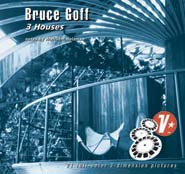Bruce Goff : 3 Houses

ESSAY
Photographing Bruce Goff in 3D
In his conversations with Philip Welch, architect Bruce Goff expressed his dissatisfaction with conventional photographic representation of architecture. Obviously referring to his own work, he stated that "many things with depth and mystery are not easily photographed." Conversely, a building without spatial complexity would invariably photograph well if the photographer were adequately skilled. Those who spent time with Goff recall that he owned a View-Master - the stereoscopic viewing device popular in the 1950s - through which one could view the world in Kodachrome and third-dimension on the small circular reels. None of this was known to me when I began the project of photographing Goff's buildings in 3D. It just seemed obvious that the spatial complexity and textural richness of his work demanded a "depth record" for its fullest comprehension and appreciation.
The project began rather unintentionally when, in 1990, I attended a conference on organic architecture organized by Professor Arne Henderson at the University of Oklahoma in Norman. The participants were offered a day tour of Goff projects in the Bartlesville area. I happened to bring along my stereo camera and was able to shoot twenty or so images of the Joe Price House and Studio, at the time owned by the university and open to the public. Never intending to "seriously" photograph the house, I rested my camera on available surfaces in order to time-expose interior views. (John Lautner accompanied us on this tour, and my favorite shot, unpublished, is of John, dressed in a green blazer, gazing in wonder at this extraordinary building.) In the years since I took them, these photographs have provided a compelling introduction to Goff's work for my students at the University of Tennessee. The stereoscopic representation enabled me to display and discuss the work in an intelligible way.
Although the View-Master project was in its initial stages of development, and the Ford House in Aurora, Illinois, had already been photographed, we didn't intend to feature Goff in the first packet until we received word of the Joe Price House's destruction in December 1996. At that point, we decided to photograph a third house and package all three in our first release entitled "Bruce Goff: 3 Houses." I was intrigued by the simplicity and traditional rectilinear geometry of the Ledbetter House in Norman, and had the wonderful experience of touring that house with its owner Professor Joe Taylor, but Goff scholars strongly recommended the Bavinger House as the architect's unequivocal masterpiece. The Bavingers graciously agreed to let me photograph the house in 3D in April 1997.
With a promise of beautiful Oklahoma spring weather, I was greeted by a week of rain, sleet, and freezing temperatures. When I arrived at the house, buckets and towels were everywhere to catch the water that, not surprisingly, managed to penetrate the complex intersections of roof, walls, and windows. While overcast lighting conditions necessitated long time exposures for the indoor views, the soft light was helpful in capturing interior details. After one day, my German stereo camera broke down and I was forced to use my backup outfit, a Nikon F fitted on a rail that slides horizontally. This enables a single camera to shoot left and right images sequentially with a separation of about 2.5 inches, equivalent to the distance between two eyes. I had the second day's film processed in Norman to evaluate the results, which were good in spite of the weather.
The summer weather in Aurora, on the other hand, was perfect for photographing the Ford House. A bright blue sky provided a perfect foil to the red-orange steel ribs of the roof structure. The house's simple plan, dramatic structure and rich palette of materials and textures make it extremely photogenic. It's in pristine condition after meticulous restoration by its current owner, professor Sidney Robinson, an architect and Goff scholar who teaches at the University of Illinois at Chicago.
View-Master, as a photographic format, is unforgiving because of its size and its final display as transparency rather than printed printed page. While digital retouching techniques can be applied to these images, they are beyond the modest budget for a project of this sort, so what the camera records is essentially what appears on the View-Master reel, without manipulation. Before traveling to Oklahoma, I studied Yukio Futagawa's brilliant photographs of Goff's work contained in his Global Architecture series. Futagawa shoots only with natural light, a strategy I believe necessary to retain accurate spatial and textural representation. Because third-dimension enables the critical rendering of textures through reflection and dispersion of light from their surfaces, artificial illumination is readily detectable and can alter the qualities of the architecture. But Futagawa's interior views, as natural as they seem, do little to help the viewer unravel the complexity and mystery of the building. It's Goff's spaces that make the photographer's task so difficult - and so challenging.
Notes ©1998 Michael Kaplan.
